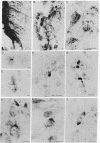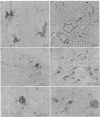Abstract
The excitotoxic brain metabolite quinolinic acid has been hypothetically linked to the pathogenesis of neurodegenerative disorders. By using antibodies prepared against a homogeneous preparation of its catabolic enzyme, quinolinic acid phosphoribosyltransferase [QPRTase; nicotinate-nucleotide:pyrophosphate phosphoribosyltransferase (carboxylating), EC 2.4.2.19], immunocytochemical methods were applied to assess the cellular and subcellular localization of quinolinic acid in the rat brain. On the light-microscopic level, the enzyme was found to be preferentially associated with glial elements of variable morphology. In addition to its presence in glial cells, QPRTase was contained in tanycytes and ependymal cells of the cerebral ventricles and, sporadically, in neurons. Overall, QPRTase immunoreactivity was noted in every brain region studied, the histological pattern being in good accordance with the regional variation of enzyme activity established in biochemical studies. As judged on the ultrastructural level, QPRTase, in all cell types examined so far, was often noted in densely stained roundish cytoplasmic bodies (0.1-0.8 micron in diameter), which were bounded by a single membrane. In functional terms, these structures may represent early lysosomes, secretory granules, or residual bodies. The particular anatomical arrangement of the quinolinic acid system may reflect the brain's defense strategy against detrimental effects of the endogenous excitotoxin.
Full text
PDF
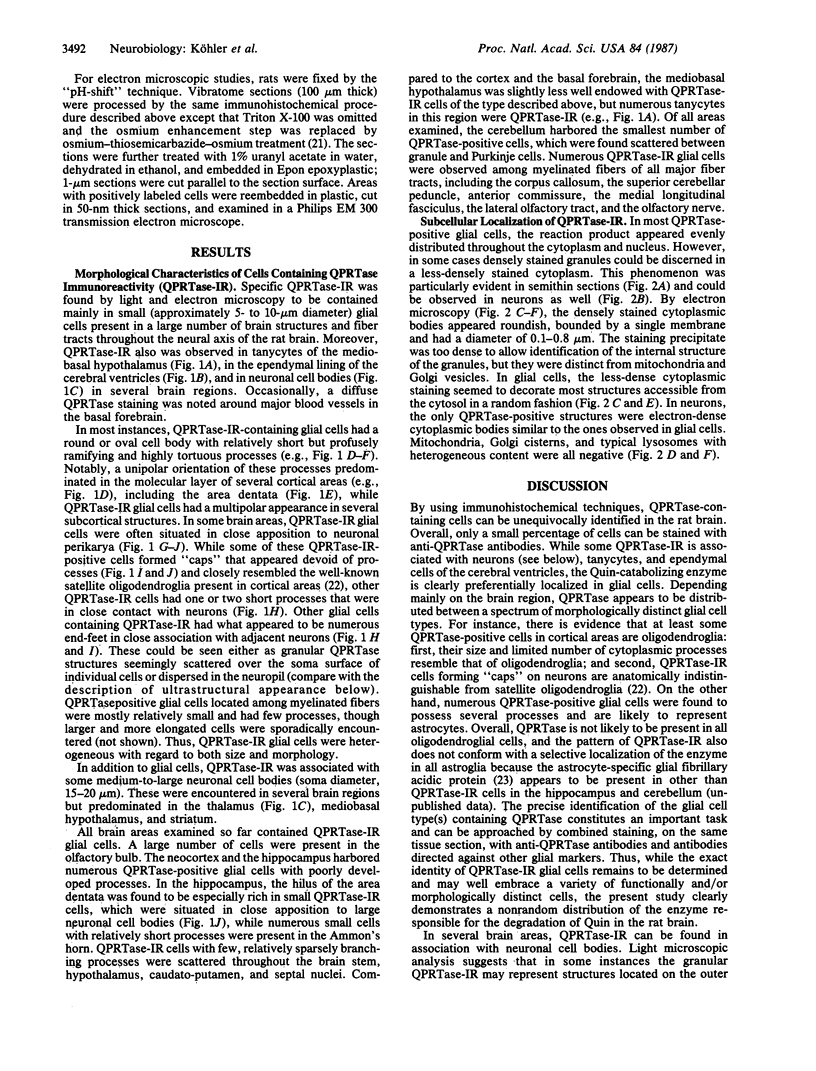
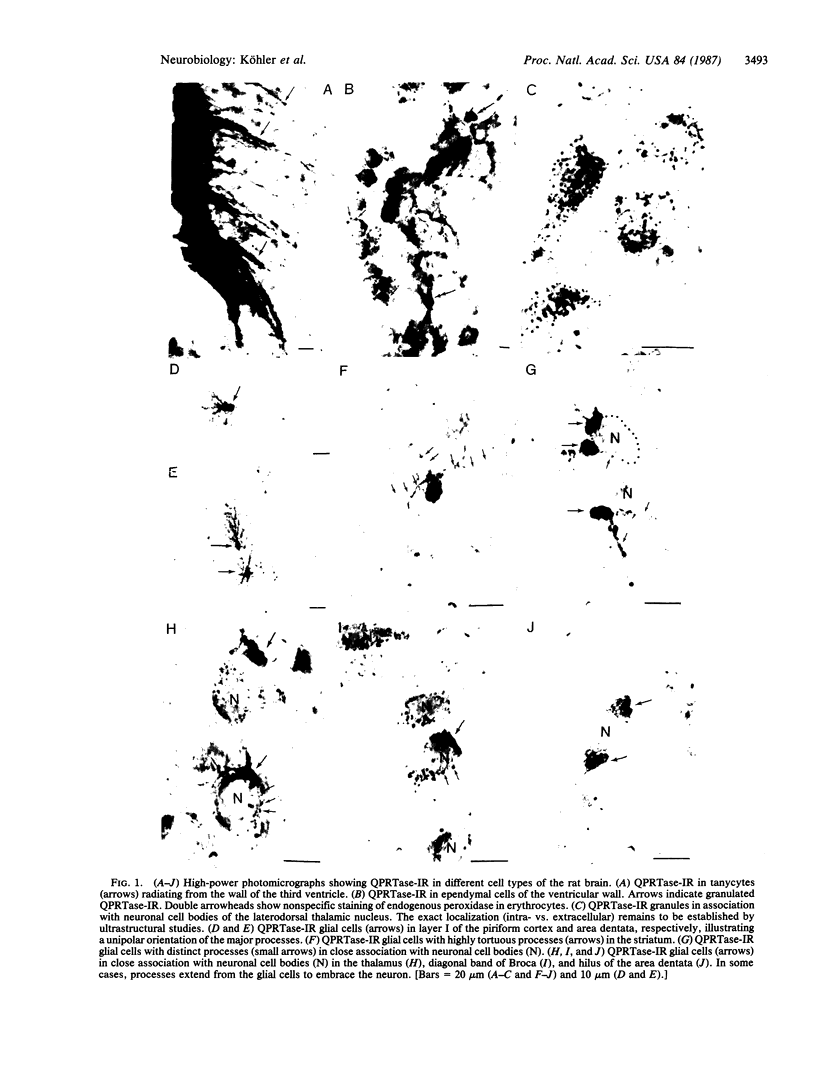
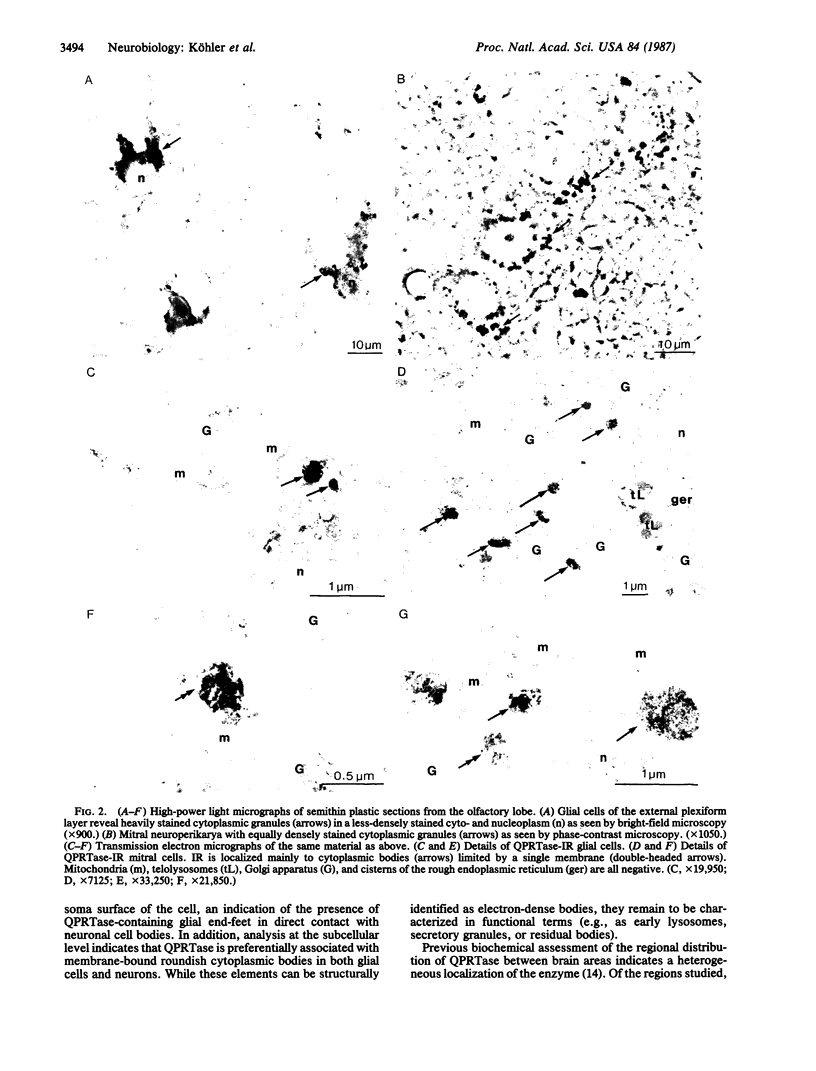
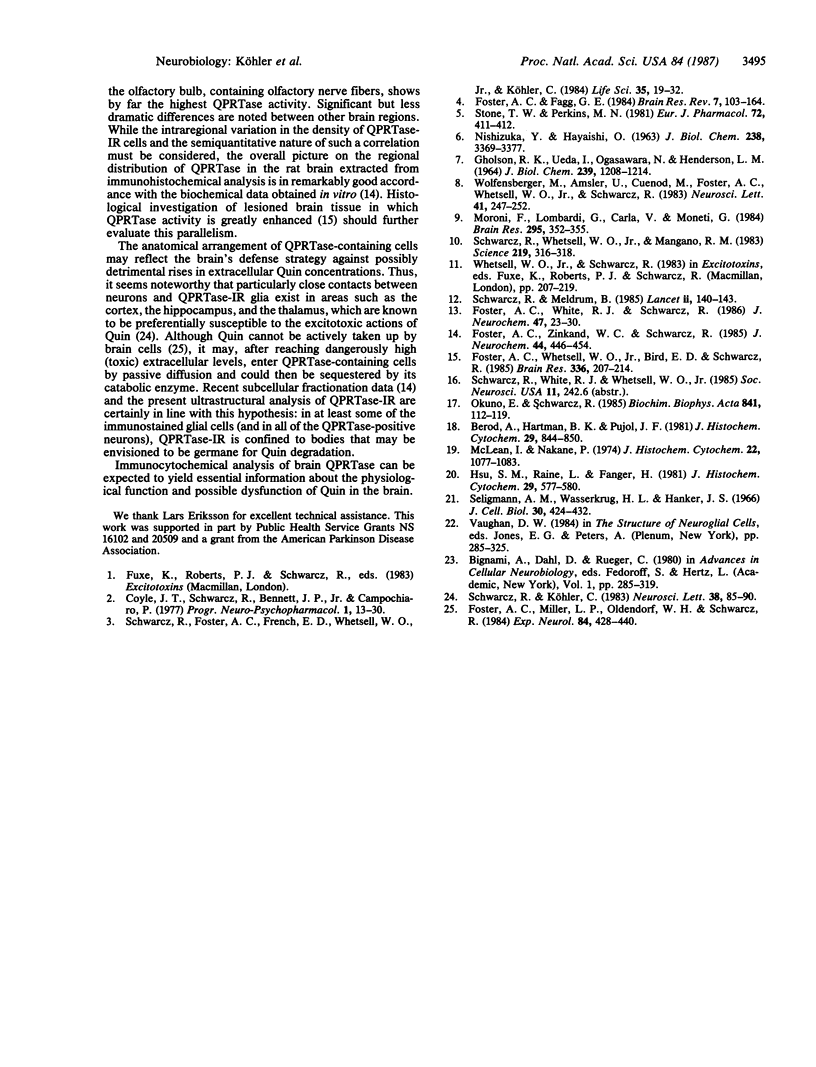
Images in this article
Selected References
These references are in PubMed. This may not be the complete list of references from this article.
- Berod A., Hartman B. K., Pujol J. F. Importance of fixation in immunohistochemistry: use of formaldehyde solutions at variable pH for the localization of tyrosine hydroxylase. J Histochem Cytochem. 1981 Jul;29(7):844–850. doi: 10.1177/29.7.6167611. [DOI] [PubMed] [Google Scholar]
- Coyle J. T., Schwarcz R., Bennett J. P., Campochiaro P. Clinical, neuropathologic and pharmacologic aspects of Huntington's disease: correlates with a new animal model. Prog Neuropsychopharmacol. 1977;1(1-2):13–30. doi: 10.1016/0364-7722(77)90025-x. [DOI] [PubMed] [Google Scholar]
- Foster A. C., Fagg G. E. Acidic amino acid binding sites in mammalian neuronal membranes: their characteristics and relationship to synaptic receptors. Brain Res. 1984 May;319(2):103–164. doi: 10.1016/0165-0173(84)90020-1. [DOI] [PubMed] [Google Scholar]
- Foster A. C., Miller L. P., Oldendorf W. H., Schwarcz R. Studies on the disposition of quinolinic acid after intracerebral or systemic administration in the rat. Exp Neurol. 1984 May;84(2):428–440. doi: 10.1016/0014-4886(84)90239-5. [DOI] [PubMed] [Google Scholar]
- Foster A. C., Whetsell W. O., Jr, Bird E. D., Schwarcz R. Quinolinic acid phosphoribosyltransferase in human and rat brain: activity in Huntington's disease and in quinolinate-lesioned rat striatum. Brain Res. 1985 Jun 17;336(2):207–214. doi: 10.1016/0006-8993(85)90647-x. [DOI] [PubMed] [Google Scholar]
- Foster A. C., White R. J., Schwarcz R. Synthesis of quinolinic acid by 3-hydroxyanthranilic acid oxygenase in rat brain tissue in vitro. J Neurochem. 1986 Jul;47(1):23–30. doi: 10.1111/j.1471-4159.1986.tb02826.x. [DOI] [PubMed] [Google Scholar]
- Foster A. C., Zinkand W. C., Schwarcz R. Quinolinic acid phosphoribosyltransferase in rat brain. J Neurochem. 1985 Feb;44(2):446–454. doi: 10.1111/j.1471-4159.1985.tb05435.x. [DOI] [PubMed] [Google Scholar]
- GHOLSON R. K., UEDA I., OGASAWARA N., HENDERSON L. M. THE ENZYMATIC CONVERSION OF QUINOLINATE TO NICOTINIC ACID MONONUCLEOTIDE IN MAMMALIAN LIVER. J Biol Chem. 1964 Apr;239:1208–1214. [PubMed] [Google Scholar]
- Hsu S. M., Raine L., Fanger H. Use of avidin-biotin-peroxidase complex (ABC) in immunoperoxidase techniques: a comparison between ABC and unlabeled antibody (PAP) procedures. J Histochem Cytochem. 1981 Apr;29(4):577–580. doi: 10.1177/29.4.6166661. [DOI] [PubMed] [Google Scholar]
- McLean I. W., Nakane P. K. Periodate-lysine-paraformaldehyde fixative. A new fixation for immunoelectron microscopy. J Histochem Cytochem. 1974 Dec;22(12):1077–1083. doi: 10.1177/22.12.1077. [DOI] [PubMed] [Google Scholar]
- Moroni F., Lombardi G., Carlà V., Moneti G. The excitotoxin quinolinic acid is present and unevenly distributed in the rat brain. Brain Res. 1984 Mar 19;295(2):352–355. doi: 10.1016/0006-8993(84)90984-3. [DOI] [PubMed] [Google Scholar]
- NISHIZUKA Y., HAYAISHI O. STUDIES ON THE BIOSYNTHESIS OF NICOTINAMIDE ADENINE DINUCLEOTIDE. I. ENZYMIC SYNTHESIS OF NIACIN RIBONUCLEOTIDES FROM 3-HYDROXYANTHRANILIC ACID IN MAMMALIAN TISSUES. J Biol Chem. 1963 Oct;238:3369–3377. [PubMed] [Google Scholar]
- Okuno E., Schwarcz R. Purification of quinolinic acid phosphoribosyltransferase from rat liver and brain. Biochim Biophys Acta. 1985 Jul 26;841(1):112–119. doi: 10.1016/0304-4165(85)90280-6. [DOI] [PubMed] [Google Scholar]
- Schwarcz R., Foster A. C., French E. D., Whetsell W. O., Jr, Köhler C. Excitotoxic models for neurodegenerative disorders. Life Sci. 1984 Jul 2;35(1):19–32. doi: 10.1016/0024-3205(84)90148-6. [DOI] [PubMed] [Google Scholar]
- Schwarcz R., Köhler C. Differential vulnerability of central neurons of the rat to quinolinic acid. Neurosci Lett. 1983 Jul 15;38(1):85–90. doi: 10.1016/0304-3940(83)90115-5. [DOI] [PubMed] [Google Scholar]
- Schwarcz R., Meldrum B. Excitatory aminoacid antagonists provide a therapeutic approach to neurological disorders. Lancet. 1985 Jul 20;2(8447):140–143. doi: 10.1016/s0140-6736(85)90238-7. [DOI] [PubMed] [Google Scholar]
- Schwarcz R., Whetsell W. O., Jr, Mangano R. M. Quinolinic acid: an endogenous metabolite that produces axon-sparing lesions in rat brain. Science. 1983 Jan 21;219(4582):316–318. doi: 10.1126/science.6849138. [DOI] [PubMed] [Google Scholar]
- Seligman A. M., Wasserkrug H. L., Hanker J. S. A new staining method (OTO) for enhancing contrast of lipid--containing membranes and droplets in osmium tetroxide--fixed tissue with osmiophilic thiocarbohydrazide(TCH). J Cell Biol. 1966 Aug;30(2):424–432. doi: 10.1083/jcb.30.2.424. [DOI] [PMC free article] [PubMed] [Google Scholar]
- Stone T. W., Perkins M. N. Quinolinic acid: a potent endogenous excitant at amino acid receptors in CNS. Eur J Pharmacol. 1981 Jul 10;72(4):411–412. doi: 10.1016/0014-2999(81)90587-2. [DOI] [PubMed] [Google Scholar]
- Wolfensberger M., Amsler U., Cuénod M., Foster A. C., Whetsell W. O., Jr, Schwarcz R. Identification of quinolinic acid in rat and human brain tissue. Neurosci Lett. 1983 Nov 11;41(3):247–252. doi: 10.1016/0304-3940(83)90458-5. [DOI] [PubMed] [Google Scholar]



